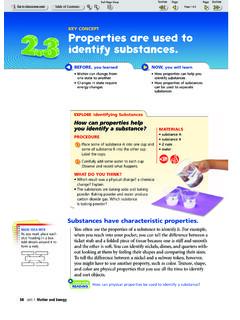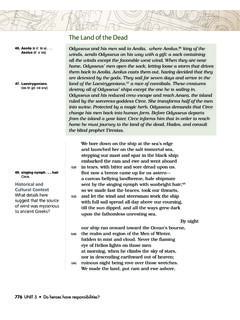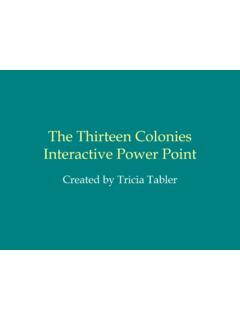Transcription of BVP1-5 Broadcast Scripts
1 Broadcast SCRIPTSACCT- BVP1-5 . Students will identify and create different script types. a. Identify Scripts by format. b. List steps leading to the development of various type ( , news and/or sitcom) Broadcast Scripts . c. Define terminology used in Broadcast scriptwriting. d. Plan and produce a storyboard. e. Write Broadcast Scripts as assigned. IntroductionToo many students experience anxiety when they hear the word writing. One of the best things that can be said about television scriptwriting is that it bears little resemblance to the writing style required for academic courses. Although scriptwriting is relatively simple to do, good scriptwriting takes talent and skillProgram FormatsA script is an entire program committed to paper. It includes dialog, music, camera angles, stage direction, camera direction, computer graphics (CG) notations, and all other items that the director or script writer feels should be are many different kinds of television programs, each with unique requirements of the script.
2 Most programs fit into one of the following categories: Lecture. The lecture program format is the easiest format to shoot; the talent speaks and the camera shoots almost entirely in a medium close-up. All that is needed for this format is the talent, a camera, and a podium for the talent to stand behind. Other names for the lecture format are BTF (big talking face) or talking head. This format has the lowest viewer retention and is often the mark of an amateur. Lecture/Demonstration. The lecture/demonstration format lends itself to the numerous cooking shows, how-to shows, and infomercials seen on television today. This format is more interesting to watch than a lecture alone because of the action and many props used by the Formats Panel Discussion. The many Sunday morning network programs that bring a group of professionals together to discuss current news and political topics are examples of the panel discussion format.
3 Also included are the popular daytime talk shows. These programs are not difficult to produce, as long as there is a limited number of people on the panel. Panel discussions are driven by the program s content, not action. As more people are added to a panel discussion, the shot to include all members gets rather wide. A wide shot is also a tall shot. This increases the risk of shooting off the top of the set. To keep the top of the set in the shot, the camera may need to tilt down and inadvertently make the studio floor the most prominent item in the picture. location or in the studio, the two-person interview can be elcetifying. Peopl like Barbara Walters have build entire careers on making a simple conversation a complelling program for the audience. The interview format is often shot with only one camera. To get various camera angle cuts between the interviewer and the interviewee, the interviewee is shot for the entire duration of the interview.
4 The audio picks up the questions asked by the interviewer , but the camera only shoots the interviewees' face. After interviewee has left the set, the camera shoots the interviewer asking same questions a second time and records some nod shots. Program FormatsNod shots are a special kind of cutaway The interviewer does not sty anything, but simply nods naturally as if listening to the answer to a question. When collecting nody shots, the interviewer faces the direction where the interviewee was positioned during the interview. In the editing room, the angles and not shots are cut together to create what looks like a conversation between the two people. documentary program is essentially a research paper for television; the topic is researched, the information is outlined, and the script is written. The audio in a documentary may be either off-camera narration, or on-camera narration, or a combination of both.
5 The audio portion f the script should be roughly written out before any shooting begins. In the process of writing, a shot sheet is develop. For a documentary program a shot sheet is like a grocery list of shots needed to support the audio portion of the script. When shooting, the shots on the list are Additionally , the director watches for other shots that include specific items, people, or anything that adds to the program's content and would be interesting to the viewers. Shot sheets are only a guide and are rarely long enough to provide enough footage to assemble an entire program. Always shoot more footage than is listed on the shot Formats term includes both dramas and comedies. The drama format requires a different kind of talent, actors. Actors take on a role in a program and perform as someone or something other than themselves. Magazine. The magazine format originated from programs like 60 minutes, but has become more than news-oriented programming.
6 A regular news Broadcast presents each story in two minutes or less. A magazine format program is comprised of feature packages that address a single story. This allows more interesting detail to be included about each story, but fewer stories to be included in each program. Music Video. The music video has become a common and influential force in our culture. Items such as clothing shoes, fashion accessories, and hairstyles gain popularity when seen in a music video. Music videos also serve to promote a band or a new song or album, in the hopes of increasing the sales of CDs and concert tickets. Most music videos are one of three types:Program Formats Concert Style. The audience sees the band perform the music that is heard. A concert style music video may include a compilation of different concerts the band has performed, a studio performance, or a various locations. Story Style. The audience hears the music, but never sees the band.
7 Instead, actors act out a story line that is supported by the lyrics of the song. A hybridof a concert style and a story style music video. When producing a music video, copyright permission is the first and foremost consideration. Do not break the law! Public Service Announcement/Ad (PSA).Generally, Public Service Announcements/Ads are 30 or 60 seconds in length. The purpose of a PSA is to inform the public or to convince the public to do (or not to do) something in the interest of common good. Anti-drug and anti-drinking and driving campaigns are examples of PSAs. A typical television ad, on the other hand, attempts to convince the public to purchase goods or is the ability to mentally picture the finished program. Visualizing a program is similar to daydreaming. The visualized details of a program should be put on paper, so that others can share the vision. Only when everyone, the crew an cast included, shares the vision for the program can it become a reality.
8 George Lucas waited to make The Phantom Menace, the fourth Star Wars film, until computer graphics technology was sophisticated enough to realistically reproduce onto the screen the creatures and worlds he visualized in his professionals use storyboards to help with visualization. Storyboards resemble comic books, in that they present a sketch of the way image on television should look. The disadvantage in using storyboards is the considerable time and talent required to draw each scene. Storyboards do, however, offer an image of the scriptwriter s vision to everyone who sees Program ProposalThe program proposal is created by the scriptwriter and provides general information about the program, including: The basic idea of the program. The applicable program format. The message to be imparted to the audience. The program s intended audience. Budget considerations. Shooting location considerations.
9 A rough program shooting program proposal is presented to an executive producer for approval, either in written form or orally in a meeting. A program proposal is presented before writing a full script, to avoid waiting time and expense on a script that may be completely rejected by the executive producer. The program proposal allows for an initial green light on the is important to think through a script idea during the initial proposal stage. Using visualization, the scriptwriter can get a feel for the program and determine the direction of the script. The executive producer may reject the proposal, accept it, or ask for further details. Depending on the selected program format, the next step may documentaries and interviews require that the program topic be researched. When interviewing someone, it is important to be proficient enough on the topic to hold a conversation that is interesting and informative.
10 When developing a research paper, the research information is often organized on note cards. The notes are then turned into individual paragraphs of the paper. In television, the individual paragraphs become OutlineIf a program proposal is accepted, creating an outline is usually the next step. All dramas, lectures, lecture/demonstrations, and documentaries use the same kind of outline. It is very brief, and not at all like the outline written for a research paper in school. An outline includes comments, noting the direction of the any of the formats described, the developed outline is submitted to the executive producer will either: Disapproves it. Tweaks the outline a bit. Gives suggestions to modify it. Approves it. - If approved, the next step is writing the actual OutlineDrama OutlineAn outline for a drama breaks each major event in the story into the fewest number of words possible and places each on a different line.





